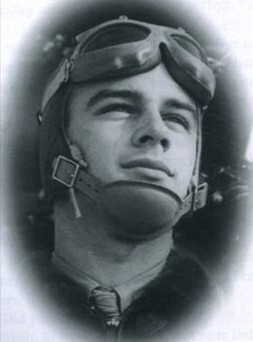
Jack Morris

VMF-218
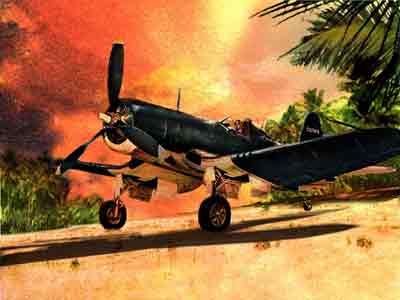
Painting by Morris
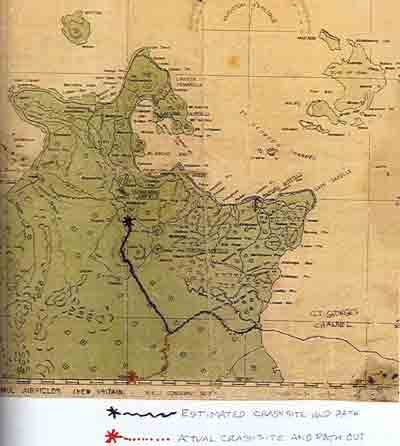
Map of Rabaul, with escape route noted Morris used
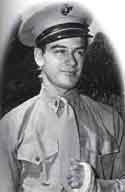
Recovering wounds
in the USA
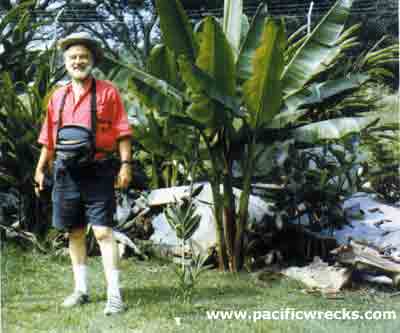
Reunited with his former aircraft in 1991
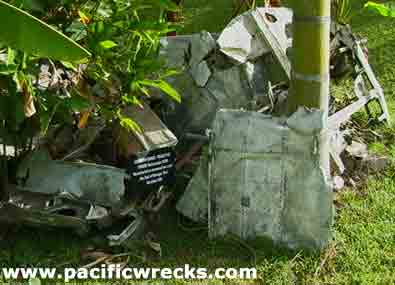
F4U at Kokopo Museum
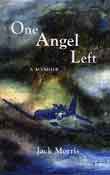
One Angel Left
by Jack Morris
|
Background
I was born in farm house near Ridgefield, Washington,
Columbia River Valley near Portland, Oregon. Grew up in Vancouver, WA,
Formerly Fort Vancouver. Loved sports and camping and hiking on slopes
below Mt. St. Helens. Majoring in P. E. at University of Oregon, I got
myself in very good physical condition just before the war which stood
me in good stead for pre-flight training and the exigencies of combat
and survival in air, land and sea.
Which reminds me of the Marine Corps:
The images that come to mind of fighting Leathernecks, are heroism,
manliness and comradeship. I and my comrades decided that was for us.
Out of US Naval Training Station, Corpus Christi, where we had been
trained in small seaplanes, we headed for Marine Corps Air Stations
on The West Coast for transitional training into fighters. At USMCAS
Mojave a number of squadrons were being formed to bolster our fighter
forces in the Southwest Pacific.
One of these was VMF-218 where I and
some of my companions landed. After a few flights in Guadalcanal stalwarts,
the venerable F4F, Wildcats, our F4U Corsairs arrived and we went to
town with formation flights, gunnery, night flights, mock combat, nav
hops, cross-country, field-carrier landing, logging many hours to get
in shape for the real thing. We flew eight days straight with a 24 hour
liberty in between for three and a half months.
Forward Training in Vanuatu
In the New Hebrides, VMF-218 stood
by at the Turtle Bay Fighter Strip as our planes were unloaded. They
were brand new Corsairs; the hottest planes in the whole Pacific Theater.
They were the first of their kind with water injection, which gave them
a 15 knot advantage over any other aircraft. We spent the next month
logging break-in hours and increasing our experiences as fledgling fighter
pilots in the art of strafing, formation flying, predawn takeoffs, mock
interceptions. We lost one plane in operational accident while chasing
tails, a midair collision. The pilot bailed out. In all of our training
period we lost 0 personnel. During that month Gregory "Pappy" Boyingyon of VMF-214
was lost in combat. I saw his personal effects by a hut at Turtle Bay Airfield later in January, 1944.
Fourth Combat Mission, February 10, 1944
We flew from the fighter strip, I think it
was Piva Airstrip (Uncle). I was on my fourth and last
combat mission and I never got to Green Island with the rest of VMF-218.
On the way to combat zone on January 31 I flew an old rehab with birdcage
canopy on ferry hop 600 miles from Espirito Santo to Guadalcanal, gladly
left it in the fighter pool at Henderson. It backfired whenever I throttled
back, made me nervous. Its was F4U Corsair 02566.
On that near-fatal day, Feb. 10, we
wre flying medium cover over a flight of B25's. We did theThatch Weave
above them, a four plane formation, split apart, two planes weaving
with two planes. The bombers flew past the target strip, then started
a sweeping turn to the starboard so as to bomb the Vunakanau field on
the way home. Fred, my leader, and I were on the outboard side of our
turn and as we were in the middle of the turn, I looked up to the left
and saw about ten Japanese fighters circling, waiting for someone to
be isolated on the edge of the big formation below: fighters at three
levels, Marine and Navy Corsairs and Hellcats, and New Zealand P40'sweaving
back-and-forth. I knew that when we completed our wide turn, I'd be
in the extremely vulnerable position as tail-end-Charlie and the zeros
would be at 6 high...
Tail-end-Charlie with 10 Bogeys at 6 high what do
you do? Call your leader, tell him it's time to turn or dive
out. but he's pulling away! Too late. Big Bang! Everything goes black;
I can't see. I hear machine gun pellets hitting the armor plate behind
my seat. I have to dive out of here! My vision is not returning! I have
to bail out! First I have to jettison the canopy; pull the release pins.
There, I got the right one, bbut, where's the other one; I can't find
it! Pull the overhead release!
Raising my right arm, grasping the
canopy handlle I pull it back as far as I can, but I pass out in the
process and a few seconds go by with my attention in limbo. When I come
to, I have no idea how far I've tumbled toward ground zero. My vision
has not returned. I feel resigned to the inevitable. I say to myself,
"This is it!"
At that moment I realize the weight
of my body is resting on seat-belt and shoulder straps. "I'm upside
down!" All I have to do is pull the belt release and I fall out,
knocking the loose canopy off with top of my head. "I'm out. Pull
the rip cord! And the next instant I'm hanging in a tree. the roar in
my ears has suddenly stopped; except for sounds of distant gunfire it's
quiet. I still can't see - I was wounded in my eye.
Behind Enemy Lines
My first fear, once down, was snipers or strafers.
So, I pulled on parachute lines and fell to ground and ran without my
equipment. When vision and wits finally returned, I went back, retreived
survival gear and saw my burning plane only a few yards from the chute.
We had come down almost in tandem. Now my aim was to reach the coast
without accosting anyone including natives. No matter how much they
tried to conceal you, word almost always got out. I heard later that
the Japanese were beheading aviators they took prisoner.
My trek through the Jungle to the coast
was accompanied by a mixture of pleasure-of-the-wild with fear-of-the-unknown with pleasure-of-successive-successes: going in good directions, finding
the little Sigule River where there was no river traffic; arriving at
the plantation at siesta time; slipping out to sea after dark to allow
enough time to reach safe distance by dawn; far enough to be slightly
out of sub's course, twice!
I spent eight days behind enemy lines,
and made my way out of the jungle and followed a river to the sea. I
was recsued by a PBY Catalina. I have researched The RZNAF Catalina
crew and have some of their names, but have not yet made contact with
them since the war.
Returning to Rabaul in 1991
About return trip to Rabaul: For many years
after my adventure on Great Britain, I looked at my
wartime Rabaul map and reasoned that my escape route had come out
of that diamond shaped configuration of roads or trails between villages
near Vunakanau strip. Since I remembered crossing one well-beaten path
I reasoned that it was that one by the villages. I day dreamed that
I would someday return there, find the wreck and return with a piece
of it. I said that a number of times.
It came true in 1991 because the Stanford
Alumni Association's
Trave/Study office mailed their brochure about a South Pacific Tour
they planned for September and I vowed I'd be there. I had time to do
my search because I arrived early in Rabaul and asked questions in the
right places and Alastair Norrie answered with, "We have it right
here in the Kokopo Museum!"
I didn't have to search through the brush; it was all layed out for
me on the grounds of the museum which I was viewing 45 minutes after
the phone call. The experience was heart-pounding and hair-raising.
Afterward, David Lindley took me to
the little river, Sigule and the beach where I had slipped out to sea
at night in 1944. He told me about the well-beat path I had crossed early in my trek. It ran between
two Japanese outposts that were above the valley my plane and I fell
into, a long way from Vunakanau.
"One Angel Left" Book
After the war I trained in fine art and engineering at Stanford, became
a designer and art and architecture teacher, cabinet and furniture maker,
theater set designer/builder, architectural designer/finish carpenter.
I've done watercolors more recently. I did the cover painting in 1999.
In 1960's I discovered I liked writing and took courses to polish my
skills. After minor success in publishing and discovery of F4U Corsair 02566 in
1991, I knew I had to write this story. So, I hooked up with a writing
group for Seniors in Sebastopol, California. We did an anthology with
a story of mine and an excerpt from "One Angel" along with
other's stories. This productive group helped immeasurably. |